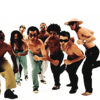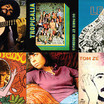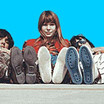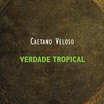Eubioticamente atraídos

tropicalism and mpb (brazilian popular music)
Brazilian views
TROPICALISM AND MPB (BRAZILIAN POPULAR MUSIC)
Antonio Cícero
August 12, 2004
It was in 1966 – a little before the start of Tropicalism, therefore, in 1967* – that Caetano Veloso made his famous statement to Augusto de Campos on the “evolutionary line” of Brazilian popular music. Allow me to quote this once more:
Only the recapturing of the evolutionary line can give us an organic overview and allow us to select and judge the creative production. To say that to make samba you only need a frying pan, drum and guitar without sevenths or ninths doesn’t solve the problem. Paulinho da Viola told me a few days ago of his need to include bass and drums on his records. I’m sure that, if he could make this need reality, he would have a bass and he would make samba, just as João Gilberto has “bass, violin, trumpet, sevenths, ninths and makes samba”. In fact, for me João Gilberto is exactly the moment when this happened: the information of musical modernity used in the recreation, in the renewal, in the going-a-step-further, of Brazilian popular music. I really believe that the recapturing of the Brazilian musical tradition must be done in the way João Gilberto did it. In spite of artists such as Edu Lobo, Chico Buarque, Gilberto Gil, Maria Betânia, Maria da Graça (little known to many people) suggesting this recapturing, with none of them did it become whole or integral. *
At the time of this statement, the evolutionary line to which Caetano was referring was only that which went from samba to bossa nova; if, however, we consider Tropicalism, which would appear a year after this statement, as precisely a recapturing of the evolutionary line in MPB, this line would have to be extended from bossa nova to Tropicalism: at this point, that is, in 1967, samba, bossa nova and Tropicalism would be the three points between which the evolutionary line of MPB would be drawn; and, in principle, the same line could be projected indefinitely beyond Tropicalism, toward a future and as yet undefined series of consecutive points.
Before continuing, I must emphasize that Caetano’s declaration does not and was never intended to have a theoretical meaning, so that he cannot be held responsible for the errors and mistakes which I may make in the interpretations and inferences that follow. As a young songwriter, he was, in fact, tracing the articulation of his musical projects, based on the reflection of what the Revista Civilização Brasileira considered the “crisis in Brazilian popular music”.* What concerned him were questions such as the difficulty of, in the quotation, having an “organic overview to be able to select and judge creative production”; and, on facing similar questions, he took into account the experiences of colleagues such as Paulinho da Viola, Edu Lobo, Chico Buarque etc.
The question of evolution in art
I would also, right now, like to confront some probable – but nonetheless not necessarily warranted – criticism about Caetano’s words, whether taken literally or in the interpretation I give them. One aspect of criticism could be to question the correctness of talking of “the” evolutionary line in MPB, as if there were only one, namely, the line that begins with samba. Since Brazil is an immensely rich country in musicality, one could ask what gives Caetano the right to talk of samba to the detriment of baião or frevo (traditional popular music from Brazil’s northeast) for example, as if samba were the blueprint for all MPB.
I believe that the best response to this objection is that the new style of MPB that gave rise to the notion of an “evolutionary line” was bossa nova; bossa nova (literally, new rhythm) refers to samba. “João Gilberto”, said Caetano in the aforementioned interview “uses bass, violins, horns, sevenths, ninths and is samba”. Bossa nova is, yet isn’t, samba: it is distinctive from traditional samba but is, in some way, its descendant and can still be seen as the bossa nova (new rhythm) of samba. The most interesting thing about bossa nova – not from the esthetic point of view, but from a purely intellectual viewpoint – was precisely its novelty. While all Brazilian popular music – and practically all popular music, with the notable exception of the American – wanted to see itself as traditional, bossa nova boasted of being new: and, evidently, it was. When, however, Caetano, talking of the “evolutionary line of Brazilian popular music”, refers to the line going from samba to bossa nova, he did so not because this was the only evolutionary line possible – obviously there are other possible lines, even in ’68, Gilberto Gil spoke of Luís Gonzaga as representing the evolution of Baião* – but because bossa nova had, consciously, been the most ambitious and successful use of “musical modernity… in the recreation, the renewal, the going-a-step-further, of Brazilian popular music.”
Another foreseeable criticism to Caetano’s words quoted above could be that it stigmatizes him with the epithet of “evolutionism”, the application of the idea itself to the evolution of art. This is also a mistaken criticism. It is simply not true that there is no evolution in art. It is conceivable, for example that a particular art, in a particular context or tradition, evolve in richness or morphological, syntactic, or semantic complexity etc. For ease and clarity, hereafter I will call this kind of evolution, technical evolution. One of the most incontestable cases of evolution in this sense is that of western music, which, as José Miguel Wisnik says in the splendid book O som e o sentido (The sound and the sense) goes from chants to polyphony, passing through tonality and onwards to disperse in atonalism, in serialism and in electronic music”.* It is not only indisputable that there is a kind of evolution within polyphony and tonalism, but, if we consider that each subsequent period maintains, at least as a theoretical possibility, what it has acquired from the previous periods, so that, for example, the rules of polyphony and counterpoint are valid from the 13th and 14th centuries to the present day (having been taken up and developed by dodecaphonism), one can also say that there has been evolution, in the sense of increasing complexity, in western music as a whole. Obviously, the increasing complexity I am talking about does not refer to individual works, but to the technique with which the individual works are produced. * In addition, we are not merely dealing with a quantitative or extensive increasing complexity, but also – which is more important – one that includes a qualitative or intensive aspect. Therefore, even though the music of Machaut or Gesualdo sounds more dissonant than that of Mozart, preceding him by several centuries, the technique of the latter incorporates a dimension that is absent from theirs. * If there is not the same contrapuntal complexity in Mozart, this is a question of choice (whether his, or that of his time, is of little importance), so that the horizon of harmonic resolution of Mozart’s music was not even conceivable by Machaut or Gesualdo.
It is only true that there is no evolution in art when the meaning is very precise: that nothing guarantees that the most evolved work in the ways already discussed is also artistically* or esthetically superior to that which is less evolved in these ways. It is therefore possible to recognize that a particular bossa nova song use modulations, chords and rhythms that are more complex than those used in a particular traditional samba, without this implying that this makes it esthetically superior or better than the latter. On the other hand, the fact that an artist can produce a masterpiece from relatively scarce resources does not mean that genuine artists do not wish to broaden their resources for expression as much as they can; even knowing that these resources will not be guarantees of producing masterpieces, since such guarantees do not exist.
Independently of this, the fact is that sometimes evolution does occur in art. In terms of complexity, this is verifiable and even measurable. That this evolution in complexity alone constitutes a real evolution in art is what is inferred by Schönberg’s affirmation “that all progress, all development leads from the simplest to the most complex, and precisely the most recent development in music, by virtue of its additional complexity, also increases all the difficulties and all the obstacles against which the innovative in music always has to struggle”. * At first sight it appears, therefore, that Caetano’s aspiration to recapture the evolutionary line in MPB is perfectly legitimate.
Technical evolution vs. conceptual elucidation
Another entirely different thing are the “evolutions” that are not susceptible to this kind of verification. I have in mind a large part of the “evolution” in avant-garde art. * One talks, for example, of an “evolution in painting toward planarity”. In fact, if there is a progression toward this, it does not consist of a technical evolution, but of an evolution, or rather, an elucidation of the concept of art. If painting has moved toward planarity, it was by abandoning perspective. The road toward planarity was a practical demonstration that painting without perspective continued to be painting: that, therefore, perspective was not essential to painting, taken as one of the fine arts. * Various artists, by different routes, and using techniques that were independent of each other, contributed to reaching this discernment. This contribution consisted simply (but we should take this “simply” with a pinch of salt) in the production of paintings which, although works of art, dispensed with perspective. Fundamentally it was not, therefore, the result of an artistic or technical evolution, but of an elucidation in the concept of painting which resulted in the negation of the need, in painting, of the use of traditional artistic techniques – of perspective. Evidently, this elucidation consists in the broadening of the concept of painting as art, which ceases to be identified with the concept worked out during the Renaissance. Instead of an evolution, a conceptual elucidation of this kind could perfectly well correspond to a simplification, or rather, a voluntary technical “involution” of a particular art form.
Modern painting is an exceptionally apt art for exemplifying the difference and even the opposition between the technical evolution of art and the elucidation of the concept of art. In music, one does not find the same opposition in such a clear form except in the second half of the 20th century, with John Cage. Before this, technical evolution and elucidation in the concept of harmony were concomitant. In this way, “western music”, as Wisnik observes, referring to the historian of harmony, Jacques Chailley, “develops throughout the harmonic series, incorporating at each phase a new level which, included as a dissonance or as a partial consonance in a period, turns into a consonance in the following moment. The widening of the band of those intervals accepted as consonance would historically follow the phases of the harmonic series.” * The development of harmony, therefore, – which, by the way, happened simultaneously to the development of the orchestra, * – represented not only the technical evolution of music but also, equally and simultaneously, the broadening of the concept of music itself. Such coincidence is not, however, a general rule, but an exception in the arts. Generally speaking, it is important to avoid theoretical confusion between the technical evolution and the elucidation of the concept of an art form.
Bossa Nova and the character of popular music
If, after these observations, we return now to examining the “evolutionary line” that I traced previously, its character is now more dubious. I said that this line extends from samba to bossa nova, and from there to Tropicalism. There is, without a doubt, a technical evolution, that is, an evolution in the sense of an increased complexity in the musical structures in traveling from samba to bossa nova, even if this journey, constituting, after all, a change that is not only quantitative, but also qualitative, cannot be reduced to merely increased complexity; but it is evident that one cannot merely say that an increase in complexity occurred that was analogous to the transition from bossa nova to Tropicalism. This transition seems to be better explained as an elucidation of the concept of popular music rather than a technical evolution. Let’s examine this more closely.
First, let’s take bossa nova. An extremely important factor to be taken into account when one thinks of the influence that it exercised, is the quality of the artists that produced it, especially João Gilberto, Tom Jobim and Vinícius de Morais. Caetano several times emphasized the fact that, for him, João Gilberto was one of the greatest Brazilian artists. In his book Verdade tropical (Tropical truth), he recounts that, at the time Tropicalism appeared, he already thought João Gilberto a great artist, in all senses: “a poet, for the rhyming rhythms and the musical phrasing that he interwove with the sounds and meanings of the words he sang. A revolutionary creator like Glauber Rocha – without the defects: without the heavy or unskilled hand; of the same stature as João Cabral and João Guimarães Rosa, but performing for a wider audience, and immediately influencing the art and daily life of Brazilians”. * Over time, Caetano’s judgement of João Gilberto became even more superlative, so much so that on some occasions, he even stated that João Gilberto was the greatest Brazilian artist of all time. Was he being hyperbolic? I believe so, but it is of little matter: what is important is to reiterate that João Gilberto is a first-class artist, whose work – as a singer and an instrumentalist – has its place among the greatest artistic achievements of our time.
This means that such achievements are possible within the realm of popular music. Consequently, the traditional hierarchy of the arts, in which popular music occupies a fairly modest place, must be reviewed. Ordinarily, “popular” is opposed, in the musical context, to erudite. A musical show qualified as “popular” presupposes that this show may be excellent in its own way, but that this way is limited: and that the more the producers and players of popular music are aware of this limitation, the better. In a similar way of thinking, there are two different, but mutually exclusive, ways of perceiving popular music. On the one hand, it can be seen as music that, contrary to the erudite, has atrophied; a music that, at the margins of history, incessantly repeats the themes and forms that it has known since time immemorial. On the other hand, it can be considered as, on the contrary, a kind of simplification, dilution or degradation of certain forms of erudite music. It is obvious that in fact there are two kinds of popular music, and that they are mixed together in the most varied ways and in the most diverse proportions. This is not, however, what João Gilberto does, nor is this bossa nova.
It isn’t necessary to prove this, given that I am speaking precisely of the novelty of bossa nova, that it doesn’t consist of a repetition of timeless themes and forms. On the other hand, I must show that it cannot be reduced to a simplification, dilution or degradation of erudite music. People speak, for example, of the influence of Debussy on Tom Jobim. I could respond by saying that the person influenced is not necessarily a diluter of that which influences him; the truth, however, is that this is not the principal question. In the case of bossa nova, of Tom Jobim or João Gilberto, what I want to say is that you only have to listen to know that this is something else, very different from erudite music, and that it has other resources and cultivates other ambitions.
In fact, I believe that, while western erudite music appears to evolve “along the harmonic series” * as the result of an analytical desire, the constitution and the eventual progression of popular music occurs as a frankly synthetic undertaking. Note that I am not saying either that erudite music is analytical or that popular music is synthetic: this would make no sense. The distinction that interests me is that occurring between the nature of the history of erudite music and the nature of the history of popular music. What I mean to say is that, while what is considered to be the history of erudite music – at least until the end of the 20th century – manifests itself as something made explicit from what is implicit in what is about to unfold, the progression of popular music manifests itself as the addition to already existing alien elements (which doesn’t exclude the – alternative or concomitant – subtraction of such elements from those already existing). This explains the fact that, at the same time that artistic evolution of western erudite music appears, in a certain way, to be a logical necessity, the application of the word “evolution” to what happens in popular music appears problematic. To whit, any structural transformation of popular music seems to be entirely contingent: it may have occurred, or it may not have occurred; or it could have occurred in a different way.
I stated above that, in the transition from samba to bossa nova, a technical evolution was manifested, that is, an evolution in the sense of an increased complexity in the musical structures. This is true, but this increased complexity should be understood as an autonomous development in samba itself. It is, indeed, an incorporation into samba – undoubtedly a very happy one – of some of the components of modern erudite music. To achieve its form, bossa nova needed these components from erudite music and used them. Although, from a viewpoint of strictly musical analysis, this can be interpreted as an evolution, such an artistic evolution is not part of any extendable evolutionary line. Bossa nova is, in the last analysis, a marvelous accomplishment that could well never have happened, as it couldn’t be found registered in the non-existent genes or in the inconceivable essence of samba or MPB. That is why neither bossa nova nor popular music needs to go through the stages that erudite music went through in its artistic evolution. If yesterday Debussy was important in making certain transformations in MPB possible, this doesn’t mean that tomorrow it should seek inspiration in Stravinsky or Schönberg: tomorrow it will perhaps prefer Bach, for example, or the modal music of the pygmies: or perhaps it would like to pleonastically close up within itself. It would be a great mistake in terms of the nature of bossa nova and popular music to think that, having incorporated intervals of sevenths and ninths, bossa nova or MPB should naturally evolve in such a way as to incorporate, for example, intervals of augmented elevenths and augmented twelfths. This error has indeed been committed by some musicians who would like to represent the vanguard of popular music. On the other hand, the symmetrically inverse mistake would be no less, that is, to suppose that popular music is constitutionally incapable of incorporating the aforementioned intervals. In any case, the tendencially synthetic nature of the development of popular music, as opposed to the tendencially analytical nature of the development of erudite music, means, among other things, that (1) a “vanguard” that promoted the technical evolution of popular music would make no sense; and (2) popular music today isn’t an imitation of erudite music fifty years ago.
At each instant, the synthetic and, therefore, contingent nature of the transformations in popular music enable it to both remain in the same place and choose amongst countless contingent paths to follow. As bossa nova showed, it is possible that some of these paths constitute technical evolutions. Although this means that popular music is able to experience occasional evolutions, this does not mean that it has an evolutionary line. It is also possible that some of the paths of popular music represent an elucidation of its actual concept. I will attempt to show that this is the case with Tropicalism. Nevertheless, the vast majority of transformations in popular music do not signify either its technical evolution or the elucidation of its concept: they are simply different combinations of existing elements.
I said at the beginning of this piece that the evolutionary line to which Caetano referred was that linking samba to bossa nova, a line which, in principle, could extend to Tropicalism. In fact, no such line can exist. If what I have been saying is correct, the transition from samba to bossa nova was firstly a unique occurrence, without extensions. In this sense, Caetano was wrong in speaking of an “evolutionary line”; but, as I have already noted, his statement had no theoretical pretensions and, if we read it carefully, we will see that, since the beginning, what really interested him was to maintain alive the possibility, allowed by bossa nova, of using the information of musical modernity in the recreation, in the renewal, in the going-a-step-further, of Brazilian popular music. By saying “evolutionary line”, he was simply opposing those who were against any innovation in popular music. So, if I am right, popular music has no obligation whatsoever; neither to evolve technically, as some of the vanguard thought, nor to remain in the place, as some nationalist defenders of its “purity” thought. It was against these that Caetano proposed his “evolutionary line”.
Vanguard vs. Circumspection
In an interview with Augusto de Campos in 1968, Caetano said:
When I arrived in Rio I was part of a position that had withdrawn into itself. I gradually began to realize that everything that had given birth to bossa nova had ended up turning into something circumspect, it was no longer daring. We all lived in a small milieu, a sort of national Ipanema… And when I began in Rio to tire of bossa nova’s withdrawal into seriousness, fear and impotence, having turned itself into precisely the opposite of what it had been, the less ‘serious’ things began to attract me. And the first of these things was what most shocked my circumspect colleagues: “yeah, yeah, yeah” – Brazilian rock and roll. I began looking at it in a different way… *
The idea of “withdrawal” here is of extreme importance. Withdrawal, or circumspection, is the act by which, through fear or impotence, one withdraws, that is, one seeks safety, you protect yourself, save yourself, you isolate something. In art, what one wants to preserve is, ostensibly, always the forms: the forms of making something and the form of the things that are made. There seemed to be a fear that the customary forms were being destroyed. Well, it’s easy to destroy individual things, but more difficult to destroy forms. To destroy an artificial form, you would have to destroy not only all the examples of the form in question, so that would be no surviving paradigms or prototypes that could be imitated, but also you would have to destroy the technique (itself a form) of producing them: but, to destroy a technique, you would have to destroy all memory (written or otherwise) of this technique. This is, in general, practically impossible. That is why nothing is more irrational than the fear of the destruction of forms. In fact, what one fears is not so much their destruction as the discovery that other forms are possible: that the customary forms were only habitual or conventional and not natural. It is to maintain the illusion that certain forms are natural – or, sometimes, supernatural – that one attempts to prevent the production of alternative forms. One also fears a domino effect in the fall of forms: if some forms that one supposes to be natural are revealed to be only conventional, what will happen to other conventional forms? “So we must preserve ourselves”, says Plato in The Republic, “from changing to a new form of music, as it is something extremely risky. In no way can we interfere with the forms of music, without interfering with some of the most important social and political conventions.”
Directly opposed to Plato, many avant-garde artists of the 20th century denounced the danger that impotence and fear represent to the evolution of their art. “Evolution,” said Kandinsky, referring to art in general, “or movement onwards and upwards is only possible when the way ahead is clear, that is, when there are no obstacles in the road… The new [artistic] value is a target of scorn and invective”.* Note that the “evolution” to which Kandinsky is referring does not consist of what I called technical evolution but rather of what I called conceptual elucidation. The barriers that this elucidation must remove are the prejudices that, as a result of which, any form not corresponding to certain specifications is excluded from the art in question: for example, prejudices according to which all authentic painting is necessarily realist or representational. Let’s read further:
This is called horror of living… The joy of living is irresistible and brings the continuous victory of new values. Only gradually does the new value win over mankind… and, when it becomes obvious to the many, this value, which was inevitably necessary today, is transformed into a wall erected against tomorrow. All evolution, that is to say, all internal development and all external culture mean, as a consequence, the removal of barriers. Barriers are constantly created from new values, which overturn the old barriers. One can, therefore, see that what is most important is not the new value, but the spirit revealed within it. And what’s more, the necessary freedom for this revelation. One can therefore see that the absolute should not be sought in the form… form is always temporary, that is, relative, as it is nothing more than the means, necessary today, through which the [artistic] revelation manifests itself, or resonates.*
The relationship of Caetano’s position to that of Kandinsky is obvious. Both consider transformation of art as a positive value. Kandinsky attacks the horror of living that erects walls against tomorrow; Caetano attacks the lack of courage, the fear and the impotence that made bossa nova retreat; Kandinsky evokes the necessary freedom to remove barriers; Caetano confesses being attracted to less serious things that shock his bossa nova colleagues; finally, when Kandinsky praises the joy of living, how can one not think of the title of the song (“Alegria, alegria” – “Joy, joy”) that launched Tropicalism?
Tropicalism as a conceptual elucidation of popular music
In his book Verdade tropical (Tropical truth), Caetano describes the process planned in the minutest detail by which the song Alegria, alegria (Joy, joy) was constructed. At a certain point, after recounting that, initially, he had thought of asking RC7, the “yeah, yeah, yeah” band of Roberto Carlos, to back him on the recording (which he ended up not doing, due “more to shyness than to esthetic choice”), he explains that it was more in line with the Tropicalist strategy “to use one or two recognizable sounds from commercial music, making the arrangement an independent element to clarify the song but that would also collide with it” than making a joint effort “in the sense of finding a homogenous sound to define the new style”. “In a way”, he continues, “what we wanted to do was the equivalent of “sampling” musical bites, and we took the arrangements as ready-made. This freed us to create any kind of fusion, a musical salad palatable to the people”. * Therefore, exclusion of any attempt to find a homogenous sound, in the manner of bossa nova, shows the radical novelty of Tropicalism, putting it not in the ambit of technical evolution but in that of conceptual elucidation. This was evidenced, in Caetano’s retelling, by the use of the “ready-made” concept, which constitutes, as we know, one of the marks of conceptual art.
The interest in Brazilian “yeah, yeah, yeah” shows that Caetano did not think – if he ever had – that bossa nova projected a technical evolutionary line which he intended to continue. “I was aware”, he says in the aforementioned paragraph in Verdade tropical (Tropical truth), “that we were being more true to bossa nova by doing something that was in direct contrast. Indeed, in the Tropicalist recordings one can find elements of bossa nova among others of a different nature, but never an attempt at forging a new synthesis or even a development of the extraordinarily successful synthesis that bossa nova had been.”
The Tropicalists were “being true to bossa nova by doing something in direct contrast” not because they were “preserving” the “purity” of bossa nova. To think this would be to forget that bossa nova itself had only been possible because the artists that produced it were capable of “violating” the “purity” of samba. If the actual “purity” of samba is nothing more than a chimera, given that, having been produced by the articulation and intermediation of rhythms, rites, dances, instruments and musical paradigms etc. of various African origins with, on the other hand, melodies, harmonies, verses, dances, instruments, musical paradigms etc. from various European origins, it always pointed to the possibility of infinite other combinations of elements from different origins, what is there to say of the “purity” of bossa nova? * What’s more – and what is more important – an attempt at “developing” bossa nova, whether successful or not, would in no way have affected the synthesis of João Gilberto-Tom Jobim, which would have continued to exist just the same, just as this had in no way affected the previous synthesis, that is, pre-bossa nova samba, which still exists today.
That the Tropicalists were doing something directly opposed to bossa nova is proven both for those who have listened to the Tropicalists songs, and for those who have read the description, quoted above, of the construction of Alegria alegria (Joy joy), or for those who have seen a recording of any Tropicalist show on TV. Why, therefore, did Caetano consider these songs or performances to be “true to bossa nova”? It is precisely because, by doing them, the Tropicalists were using the information of musical modernity in the recreation, in the renovation, in the going-a-step-further of Brazilian popular music. Since the beginning, as we have already seen, it was in this aspect that Caetano intended to emulate bossa nova.
It is anyway evident that the novelty introduced by Caetano does not reside in developing bossa nova from a technical viewpoint, but rather in the conceptual elucidation of both Brazilian popular music and popular music in general. He does this by producing songs that have two qualities:
(1) Instead of following the traditional models of Brazilian music (including those of bossa nova), they (the songs) prefer to experiment with new things “abrir as janelas / pra que entrem todos os insetos”, (“open the windows/ so that all the insects can come in”), as he would say in Janelas abertas # 2 (Open windows # 2); and
(2) They are considered by Caetano himself to belong to MPB, and recognized as such by the public.
Without the second quality, the songs that he produced, would not, like “yeah, yeah, yeah”, have affected MPB, which would have maintained its circumspection. The fact is that the Tropicalist songs do not acquire their whole meaning and force except when considered as the revolutionary modification, agitation and transformation of MPB, with which they only become confounded when they distance themselves enough to comment on it. The Brazilian public accepts these songs as belonging to MPB by recognizing them as their own and loving and admiring them. We should here quote the Ezra Pound of the Pisan Cantos: “what you love well is your true heritage / what you love well will never be taken from you”. * The Tropicalist songs are too Brazilian and too good to be excluded from MPB.
In summary, the conceptual elucidation effected by Tropicalism shows that MPB has no preset limits, as it has no essence. Such elucidation destroys the bases upon which one considers certain genres or forms as essentially and in a privileged manner Brazilian in detriment to others; on the contrary, it allows the composer / singer entry, without preconceptions, not only to the whole of contemporariness, but also to all of tradition, in a way that was not even conceivable when idolatry or fetishism of this or that traditional form was the norm. And this is why the Tropicalist is able to bring to the surface genres, songs and singers which found themselves condemned to ostracism by the involuntarily provincial representatives of “good taste”.
However, a caveat must be attached to this affirmation that Tropicalism, like bossa nova, used the information of musical modernity in the recreation, in the renewal, in the going-a-step-further of Brazilian popular music: and this is that it was not only the musical information of modernity that it brought to MPB but the information of modernity pure and simple: the musical, poetic, cinematographic, architectonic, pictorial, plastic and philosophical etc. information of modernity. In this context, the information of modernity should be understood as the de-folklorization and de-provincialization of popular music, that is to say, as its insertion into the historical world in which the universal arts unfold: nothing less than the proclamation of its coming of age.
* V., p. ex., Caetano Veloso, Verdade Tropical (São Paulo: Companhia das Letras, 1997), chapter “Alegria, alegria”, p.156.
** Cit. p. Augusto de Campos, “Boa palavra sobre a música popular”, in Balanço da bossa (São Paulo: Perspectiva, 1978), p.63. Italicized by me.























